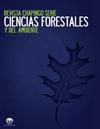Analysis of basal area increment of Pinus hartwegii Lindl. at different altitudes and aspects on Jocotitlán Mountain, State of Mexico
IF 0.6
4区 农林科学
Q3 Agricultural and Biological Sciences
Revista Chapingo Serie Ciencias Forestales Y Del Ambiente
Pub Date : 2020-12-01
DOI:10.5154/r.rchscfa.2019.10.074
引用次数: 2
Abstract
Introduction: Basal area increment (BAI) is an indicator of forest productivity that varies with tree age and site factors such as soil and climate. Objective: To generate tree-ring width index (RWI) and BAI chronologies of Pinus hartwegii Lindl., relate them to climatic variables, and study the variation in BAI at different altitudes and aspects. Materials and methods: Four observation sites were identified, combining northwest (NW) and southwest (SW) aspects, as well as altitudes of 3 800 and 3 700 m. At each site, the temperature was recorded every four hours for 435 days and 32 growth ring segments were collected using a Pressler´s increment borer. Tree-ring width was measured and BAI was calculated; the correlation index between these indicators and the climatic variables was Pearson’s correlation coefficient. Results and discussion: The RWI series from the four observation sites had an intercorrelation of 0.33 (P < 0.01). Two low-growth periods were detected, one between 1950 and 1960 and the other between 1990 and 2005. Site SO-3700 had a different growth pattern, due to a second growth phase beginning in 1978, possibly a benefit resulting from increased temperature. The previous autumn temperature, spring temperature and April-September precipitation of the current year explained the variation in BAI (P < 0.05). Conclusion: The BAI of P. hartwegii could respond favorably to the predicted increases in temperature at an altitude of 3 700 m with southwest aspect.红松林基底面积增量分析。在不同的高度和角度在Jocotitlán山,墨西哥州
简介:基底面积增量(BAI)是森林生产力的一个指标,随树龄和土壤和气候等场地因素的变化而变化。目的:建立哈特韦松年轮宽度指数(RWI)和BAI年表。,将它们与气候变量联系起来,并研究BAI在不同海拔和不同方面的变化。材料和方法:确定了四个观测点,结合西北(NW)和西南(SW),海拔3800米和3700米。在每个观测点,每四小时记录一次温度,持续435天,并使用Pressler增量蛀虫收集32个生长环片段。测量树木年轮宽度并计算BAI;这些指标与气候变量之间的相关指数为Pearson相关系数。结果与讨论:四个观测点的RWI序列之间的相关性为0.33(P<0.01)。发现了两个低生长期,一个在1950年至1960年,另一个在1990年至2005年。由于1978年开始的第二个生长阶段,位点SO-3700具有不同的生长模式,这可能是温度升高带来的好处。以前的秋季温度、春季温度和当年4月至9月的降水量解释了BAI的变化(P<0.05)。
本文章由计算机程序翻译,如有差异,请以英文原文为准。
求助全文
约1分钟内获得全文
求助全文
来源期刊
CiteScore
1.20
自引率
16.70%
发文量
0
审稿时长
>12 weeks
期刊介绍:
The Revista Chapingo Serie Ciencias Forestales y del Ambiente (RCHSCFA) is a scientific journal that aims to raise awareness of high-quality research products related to forest, arid, temperate and tropical environments in the world. Since its foundation in 1994, the RCHSCFA has served as a space for scientific dissemination and discussion at a national and international level among academics, researchers, undergraduate and graduate students, forest managers and public/private entities that are interested in the forest environment.
All content published in the journal first goes through a strict triple-blind review process and is published in the following formats: Scientific Articles, Review Articles, Methodologies, Technical or Technological Notes.

 求助内容:
求助内容: 应助结果提醒方式:
应助结果提醒方式:


